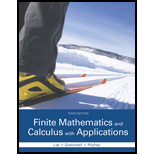
Concept explainers
Time of Traffic Fatality In Exercise 51 of the previous section, the probability density function for the number of fatal traffic accidents was found to be
S(t)=191,762(−2.416t3+90.91t2−846.8t+4880)
where t is the number of hours since midnight on [0, 24]. Calculate the expected time of day at which a fatal accident will occur. Source: The National Highway Traffic Safety Administration.
51. Time of Traffic Fatality The National Highway Traffic Safety Administration records the time of day of fatal crashes. The table on the next page gives the time of day (in hours since midnight) and the frequency of fatal crashes in 2012. Source: The National Highway Traffic Safety Administration.
(a) Plot the data. What type of function appears to best match these data?
(b) Use the regression feature on your graphing calculator to find a cubic equation that models the time of day, t, and the number of traffic fatalities, T(t). Use the midpoint value to estimate the time in each interval. Graph the function with the plot of the data. Does the graph fit the data?
| Time of Day | Midpoint of Interval (hours) | Frequency |
| 0–3 | 1.5 | 3817 |
| 3–6 | 4.5 | 2560 |
| 6–9 | 7.5 | 2950 |
| 9–12 | 10.5 | 2982 |
| 12–15 | 13.5 | 3973 |
| 15–18 | 16.5 | 4964 |
| 18–21 | 19.5 | 5003 |
| 21–24 | 22.5 | 4310 |
| Total | 30,559 |
(c) By finding an appropriate constant k, find a function S(t) – kT(t) that is a probability density function describing the probability of a traffic fatality at a particular time of day.
(d) For a randomly chosen traffic fatality, find the probabilities that the accident occurred between 12 A.M. and 2 A.M. (t = 0 to t = 2) and between 4 P.M. and 5:30 P.M. (t = 16 to t = 17.5).
Want to see the full answer?
Check out a sample textbook solution
Chapter 18 Solutions
Finite Mathematics and Calculus with Applications (10th Edition)
- I need help in ensuring that I explain it propleryy in the simplifest way as possiblearrow_forwardI need help making sure that I explain this part accutartly.arrow_forwardPlease help me with this question as I want to know how can I perform the partial fraction decompostion on this alebgric equation to find the time-domain of y(t)arrow_forward
- Please help me with this question as I want to know how can I perform the partial fraction on this alebgric equation to find the time-domain of y(t)arrow_forwardEvaluate F³ - dr where ♬ = (4z, -4y, x), and C' is given by (t) = (sin(t), t, cos(t)), 0≤t≤ñ .arrow_forwardMid-Term Review Find the formula for (f + g)(x). f(x) = x² - 10x + 25 and g(x) = x² - 10x + 24 (f + g) (x) = [ 2 ]x² X + DELL Skip Sarrow_forward
- Calculus III May I please have some elaborations on Example 2 part a? Thank you.arrow_forward1. A bicyclist is riding their bike along the Chicago Lakefront Trail. The velocity (in feet per second) of the bicyclist is recorded below. Use (a) Simpson's Rule, and (b) the Trapezoidal Rule to estimate the total distance the bicyclist traveled during the 8-second period. t 0 2 4 6 8 V 10 15 12 10 16 2. Find the midpoint rule approximation for (a) n = 4 +5 x²dx using n subintervals. 1° 2 (b) n = 8 36 32 28 36 32 28 24 24 20 20 16 16 12 8- 4 1 2 3 4 5 6 12 8 4 1 2 3 4 5 6arrow_forward= 5 37 A 4 8 0.5 06 9arrow_forward
- Consider the following system of equations, Ax=b : x+2y+3z - w = 2 2x4z2w = 3 -x+6y+17z7w = 0 -9x-2y+13z7w = -14 a. Find the solution to the system. Write it as a parametric equation. You can use a computer to do the row reduction. b. What is a geometric description of the solution? Explain how you know. c. Write the solution in vector form? d. What is the solution to the homogeneous system, Ax=0?arrow_forward2. Find a matrix A with the following qualities a. A is 3 x 3. b. The matrix A is not lower triangular and is not upper triangular. c. At least one value in each row is not a 1, 2,-1, -2, or 0 d. A is invertible.arrow_forwardFind the exact area inside r=2sin(2\theta ) and outside r=\sqrt(3)arrow_forward
 Glencoe Algebra 1, Student Edition, 9780079039897...AlgebraISBN:9780079039897Author:CarterPublisher:McGraw Hill
Glencoe Algebra 1, Student Edition, 9780079039897...AlgebraISBN:9780079039897Author:CarterPublisher:McGraw Hill
 Trigonometry (MindTap Course List)TrigonometryISBN:9781337278461Author:Ron LarsonPublisher:Cengage Learning
Trigonometry (MindTap Course List)TrigonometryISBN:9781337278461Author:Ron LarsonPublisher:Cengage Learning College Algebra (MindTap Course List)AlgebraISBN:9781305652231Author:R. David Gustafson, Jeff HughesPublisher:Cengage Learning
College Algebra (MindTap Course List)AlgebraISBN:9781305652231Author:R. David Gustafson, Jeff HughesPublisher:Cengage Learning Functions and Change: A Modeling Approach to Coll...AlgebraISBN:9781337111348Author:Bruce Crauder, Benny Evans, Alan NoellPublisher:Cengage LearningAlgebra & Trigonometry with Analytic GeometryAlgebraISBN:9781133382119Author:SwokowskiPublisher:Cengage
Functions and Change: A Modeling Approach to Coll...AlgebraISBN:9781337111348Author:Bruce Crauder, Benny Evans, Alan NoellPublisher:Cengage LearningAlgebra & Trigonometry with Analytic GeometryAlgebraISBN:9781133382119Author:SwokowskiPublisher:Cengage





